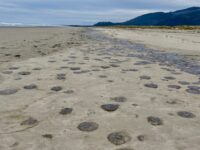Mile 289 Report
Kincheloe Point, South Jetty Tillamook River
September 21, 2020
September 15 ended the nesting bird restrictions on mile 289.
Report Details
September 15 ended the nesting bird restrictions on mile 289. We always take our dog so it was the first complete survey for some time. Originally the zone started at the south end of 289, but now the start is farther north. It probably is a kilometer in length, .6 miles. The area at the jetty has a legal passage way between the jetty and the restricted area. A loop is still possible, but don't bring the dog during the nesting season.The dry sand area was very clean. I saw just 2 plastic bottles. The wrack line had a heavy deposit of eel grass. Most of the human produced garbage was in the wrack and made of plastic.
Conditions
Temperature: 60 F. Cloud Cover: Cloudy. Wind Velocity: Calm/Light. Wind Direction: S. Tide Level: 8.0 feet.
Human Activities
Number of people: 2. Sitting: 2.
Concerns
Vehicles
Beached Birds
Total dead birds: 3. 2 gulls. One was immature and the other was probably a western gull. The 3rd find was a cormorant, unknown species.
Driftline Content
Small rocks, Seaweeds and seagrass, Shells, Animal casings (e.g., crab, shrimp molt), Wood pieces, Land-based debris (picnics, etc.), Ocean-based debris (from fishing boats, ship trash, etc.). The upper beach was very clean. The wrack had more garbage. I suspect that the debris was ocean-based, the 1 dirty crab float was for sure. Crab shells and bay clams were prominent, but a few razor clam shells were present.
New Development
none
Man-made Modifications
none
Natural Changes
Over the years, mile 289 was widened as more sand is deposited at the south jetty of Tillamook Bay. At the end of the summer, sand has built up in the dry sand area from the dunes seaward to the highest tidal line. The sand is in longitudinal dunes 2 to 4 foot high with beach grass growing in the upper sections. As you walk north or south, you move up and down these dunes like crossing ocean swells.


Report Images
All Mile 289 Reports
Mile 289
Kincheloe Point, South Jetty Tillamook River
This mile is not surveyed 4 times a year since it became a designated bird nesting area.
ollikainen
Mile 289
Kincheloe Point, South Jetty Tillamook River
There is no trace of nesting bird protection.
ollikainen
Mile 289
Kincheloe Point, South Jetty Tillamook River
September 15 ended the nesting bird restrictions on mile 289.
ollikainen
Mile 289
Kincheloe Point, South Jetty Tillamook River
I saw so many different types of birds along the jetty, I'm no bird expert but I thought I saw pelicans, herons, cormorants, and sea gulls.
EJD
Mile 289
Kincheloe Point, South Jetty Tillamook River
Mile 289 is again restricted due to bird nesting.
ollikainen
Mile 289
Kincheloe Point, South Jetty Tillamook River
This survey was all about the jelly fish that covered the most recent wrack areas.
ollikainen
Mile 289
Kincheloe Point, South Jetty Tillamook River
This is a partial survey.
ollikainen
Mile 289
Kincheloe Point, South Jetty Tillamook River
The signage is up again keeping all dogs off Mile 289.
ollikainen








